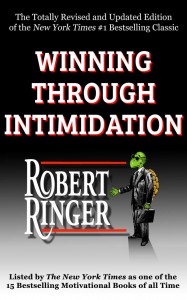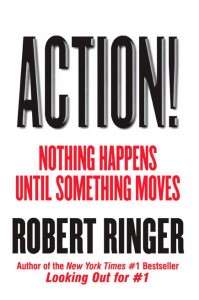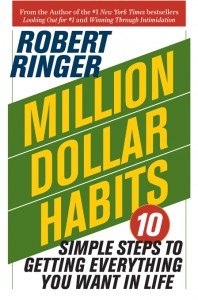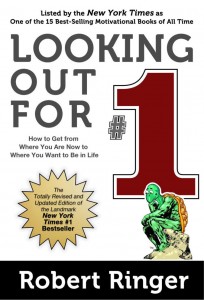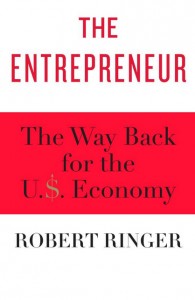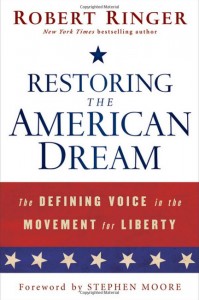Thinking and Consequences
Posted on November 1, 2016 by Robert Ringer
I have often been asked if thinking can be considered a form of action. The short answer is yes. To employ Aristotelian logic, since thoughts have consequences, we can reasonably conclude that thoughts are actions.
But the whole notion of thinking as a form of action puts us on that proverbial slippery slope. Like physical action, not all “thought action” is constructive. For example, pointless daydreaming and dispersed attention (where your mind resembles a pinball machine) are two kinds of thinking that are unlikely to add value to your life.
Since thoughts are actions, and actions have consequences, you become a product of your thoughts. Which is why it’s so important to be careful about the company you keep.
If you allow yourself to be in the presence of negative people too much of the time, it’s virtually a physiological impossibility to think positive thoughts. And since most of the people roaming our planet tend to be negative, it takes a great deal of vigilance to keep them at bay.
It’s also important to recognize that just as all physical action is not necessarily constructive, neither is all thought action. Hateful thoughts bring about hateful consequences. Negative thoughts bring about negative consequences. And so on.
That said, following are three of the more important types of thinking of which you should be constantly aware.
Immediate-Solution Thinking
This is the most common type of thinking — and the most dangerous. It can bury you alive if you allow it to guide your actions rather than the other way around. I find that the more I pressure-cook my perceived problems, the less likely I am to solve them.
I used the adjective perceived because, in truth, there really is no such thing as a problem. “Problem” is just a word we use to describe a fact or set of facts. Worse, it’s a word that carries with it a negative connotation.
I would therefore suggest that you stop thinking of every obstacle you encounter as a problem. Instead, posit it as a fact that you simply need to find a way to deal with.
By far, the best way to deal with an unpleasant fact is to turn it over to your subconscious mind with instructions to resolve it in a positive manner. The power of the subconscious mind is still a great mystery to the scientific world. But the one thing that is pretty well accepted by all experts who study of the subconscious mind is that it tends to produce that which the conscious mind requires of it.
Opportunity Thinking
Once you’ve offloaded your perceived problems to your subconscious mind, your conscious mind is free to focus on opportunities. Opportunities provide the means to move forward with your life. It’s good to be a problem solver, but problem-solving is not good enough. It’s analogous to treading water.
Try concentrating daily on how much time you spend thinking about problems and how much time you spend thinking about opportunities. If you keep your ratio at 10:1 or better in favor of opportunity thinking, you’re virtually guaranteed to succeed at just about anything you try.
The ultimate triumph of opportunity thinking is when you become adept at dissecting your perceived problems and discovering hidden opportunities in them. This is an invaluable skill that is sorely lacking in most of the human race.
Free-Flow Thinking
Free-flow thinking is not the same as daydreaming, which can be likened to being adrift at sea. I’ve found that allowing my mind to “float” can be very productive, provided my general framework is clear and meaningful.
Examples would be to ask yourself such questions as: What do I enjoy? What am I good at? What do I want out of life? What’s the price? Am I willing to pay it?
These are questions that require ongoing maintenance if you want to avoid becoming locked into a way of life that is neither profitable nor fulfilling. Monitoring the answers to these questions is a great preventative to homeostasis (the tendency to live with existing conditions and avoid change). And the more things change, the more often you should revisit these questions.
One last note on the subject of thinking as a form of action: In the name of efficiency, it’s important to develop a means for capturing your thoughts, recording and cataloging them, and being able to access them quickly. This is one of the best-kept secrets of being a good writer.
The first and simplest step in this process is to make certain that you’re within reach of a pad and pen at all times. Don’t count on remembering a great thought, because, I can tell you from experience, you probably won’t. At last count, I have forever lost track of 6,822 of my best ideas — ideas that I was certain I would remember.
Also, don’t be a lazy note-taker. Date your notes (date everything!) and make them more detailed rather than less. In an interview I once did with Hugh Downs, he told me a humorous anecdote about a note he had scribbled on a little piece of paper that read “phone bill.” The next day, note in hand, he searched for an unpaid telephone bill. Finding nothing, he was mystified as to what the note meant — until sometime later, when he was reminded by a friend named Bill that he had been waiting for his call.
To be an action-oriented person, you must make it a point to consciously use thinking as a regular and constructive form of action. Your first priority should be immediate-solution thinking; second, opportunity thinking; third, free-flow thinking.
Above all, spend as little time as possible thinking about “problems,” because problems tend to evaporate when you’re primarily focused on the other three kinds of thinking — especially opportunity thinking.
You’ve undoubtedly heard the expression, “Think before you act.” I say, “Think before you think.” Thinking is action, and actions have consequences.
A final word of caution: Don’t make the mistake of allowing thought-inspired action to become a replacement for physical action. Notwithstanding anything I have said in this article, the fact remains that there is nothing on this earth as powerful as consistent, bold, physical action.





